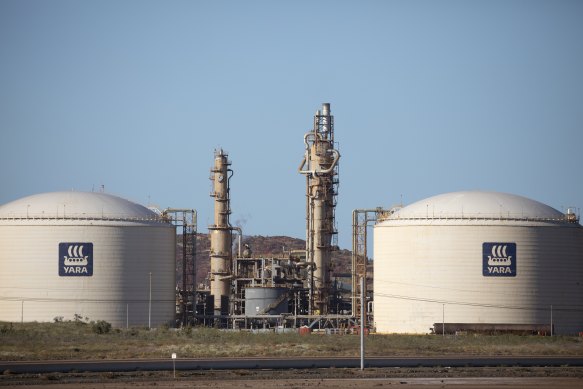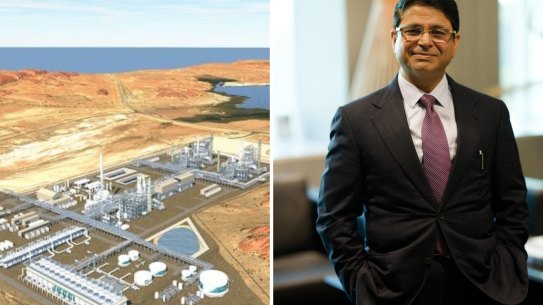Have they considered Hazer, and if not, why not ?Paying green hydrogen’s way in WA will be harder than the hypeMay 28, 2024 — 11.42am
A cautionary tale for Australian companies rushing into the nascent clean fuel business: fertiliser giant Yara has made hydrogen for a century, but struggles to justify investment in the Pilbara to reduce emissions.
The Norwegian company’s long heritage producing hydrogen to make ammonia, the key ingredient for many vital fertilisers, refutes the idea there is anything new about much-hyped hydrogen.
The Yara Pilbara ammonia plant is sited on the Burrup Peninsula near two Woodside gas export plants.CREDIT:KRYSTLE WRIGHT
It has long been made by extracting it from coal or gas – with an unfortunate byproduct. Immense amounts of climate-warming carbon dioxide.
What is new? Its possible use as a clean fuel when batteries may be impractical, like in long-distance heavy haulage and shipping – if it can be made with much less carbon pollution.
Laurent Trost, general manager of Yara Pilbara, runs one of the world’s biggest ammonia plants. It turns gas into 800,000 tonnes of ammonia a year and emits 1.5 million tonnes of CO₂, making it the seventh-biggest industrial polluter in the state.
“Obviously, we need to decarbonise this,” Trost told the annual conference of oil and gas lobby group AEP in Perth last week.
Yara first looked at so-called green hydrogen, separated from water using machines called electrolysers that, if themselves powered by renewable energy, produce an emissions-free product.
At the cost of $87 million – more than half from the federal government’s Australian Renewable Energy Agency – Yara and French energy utility ENGIE are building a pilot plant powered by a 20-megawatt solar farm to supply 1 per cent of the hydrogen the Pilbara plant needs.
“The economics are not there yet,” Tront said of the viability of full-scale green hydrogen production.
“It will be possible maybe 15 to 20 years from now, so we have to find another solution.”
The caution contrasts with Yara’s plans just three years ago to have a full-sized green hydrogen and ammonia plant operating by its existing plant by 2030.
The only other way Yara can reduce emissions from hydrogen production is to capture the carbon before it is released into the atmosphere, and store it underground.
Fortunately, 75 per cent of the CO₂ is easily captured as it is a pure stream given off the chemical reactions to make hydrogen.
In contrast, exhaust gases from a gas-fired power station contain just four per cent CO₂ and capturing that is vastly more involved.
Yara is talking to both Woodside and Santos about carbon storage sites they are developing off the Pilbara coast using depleted gas fields, but the numbers are not stacking up.
Trost said it costs Yara about $US300 a tonne to make ammonia in the Pilbara now and with carbon capture and storage tech, the so-called “blue ammonia” would cost about $US450 a tonne. Unfortunately, in the United States, blue ammonia can be made for less than $US200 a tonne.
The difference is that in the States, large long-term volumes of affordable gas are available and the US Inflation Reduction Act may provide helpful subsidies. In contrast, the WA gas market is expected to be tight for the next decade or more and the 15 to 20 years of cheap gas Trost needs is unlikely to be available.
Woodside and Santos may miss out on a customer for their carbon capture and storage projects because they cannot supply the gas it needs to produce the waste product to be stored.
Trost said the high costs endangered the viability of his Pilbara operation.
EDITOR'S PICK
“I still have to convince my investor in Oslo that it’s better to invest in carbon capture and storage than the do-nothing option; or even to close the plants,” he said.
While Yara, where hydrogen production is its core business, struggles to see how a low-emissions version is a viable business, two of WA’s biggest companies are considering investment.
Andrew Forrest’s iron ore miner Fortescue famously pivoted into green hydrogen with messianic zeal a few years ago, but progress has been slower than expected.
In 2021 Woodside had a bet each way: a proposed hydrogen plant in Kwinana south of Perth that would make both green hydrogen and conventional “grey” hydrogen (with carbon offsets for those emissions). Construction had then been slated to start in 2024, but now no date is given.
Woodside chief executive Meg O’Neill last week highlighted another problem for low-emissions blue or green hydrogen and ammonia – who will pay the price premium, especially without Woodside’s preferred climate policy of a global carbon price?
“Critical path on all of our hydrogen projects is customer demand and getting customers who are willing to sign the dotted line ... at a price that allows us to meet our return expectations,” she said.
Trost sees hope of premium pricing for cleaner hydrogen after about 2030, when he expects the use of ammonia as a fuel to start growing rapidly.
WA Premier Roger Cook, perhaps without meaning to, excellently summed up Australia’s confused hydrogen hype at the oil and gas conference last week: “We know where we’re going, we just don’t know what the destination is.”
- Forums
- ASX - By Stock
- Hydrogen News
Have they considered Hazer, and if not, why not ?Paying green...
-
- There are more pages in this discussion • 120 more messages in this thread...
You’re viewing a single post only. To view the entire thread just sign in or Join Now (FREE)
Featured News
Add HZR (ASX) to my watchlist
 (20min delay) (20min delay)
|
|||||
|
Last
37.0¢ |
Change
0.010(2.78%) |
Mkt cap ! $85.14M | |||
| Open | High | Low | Value | Volume |
| 38.0¢ | 38.5¢ | 36.0¢ | $249.6K | 672.9K |
Buyers (Bids)
| No. | Vol. | Price($) |
|---|---|---|
| 2 | 4000 | 36.5¢ |
Sellers (Offers)
| Price($) | Vol. | No. |
|---|---|---|
| 37.5¢ | 27178 | 3 |
View Market Depth
| No. | Vol. | Price($) |
|---|---|---|
| 2 | 4000 | 0.365 |
| 3 | 79866 | 0.360 |
| 4 | 21800 | 0.355 |
| 8 | 72210 | 0.350 |
| 2 | 29000 | 0.345 |
| Price($) | Vol. | No. |
|---|---|---|
| 0.375 | 27178 | 3 |
| 0.380 | 33375 | 3 |
| 0.385 | 4940 | 1 |
| 0.390 | 20318 | 3 |
| 0.395 | 24000 | 1 |
| Last trade - 15.55pm 28/06/2024 (20 minute delay) ? |
Featured News
| HZR (ASX) Chart |
The Watchlist
LU7
LITHIUM UNIVERSE LIMITED
Alex Hanly, CEO
Alex Hanly
CEO
SPONSORED BY The Market Online












